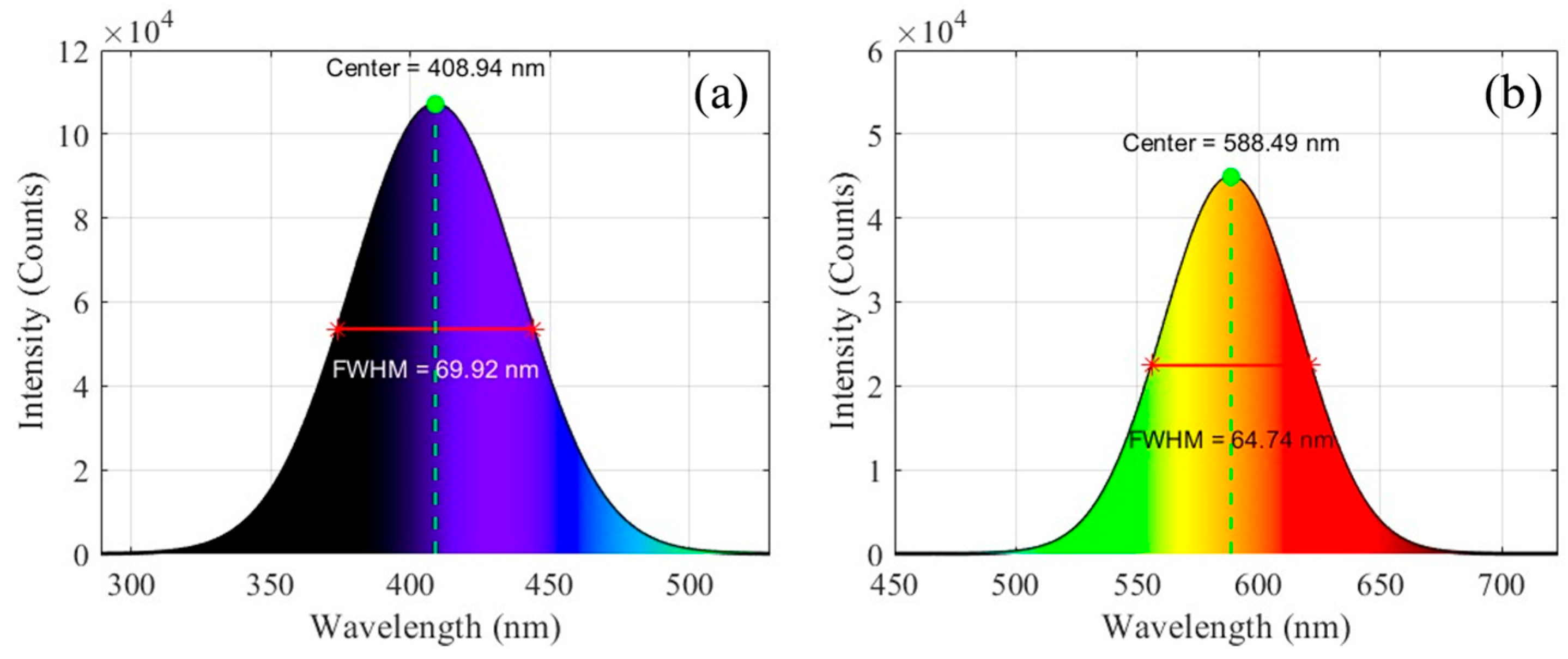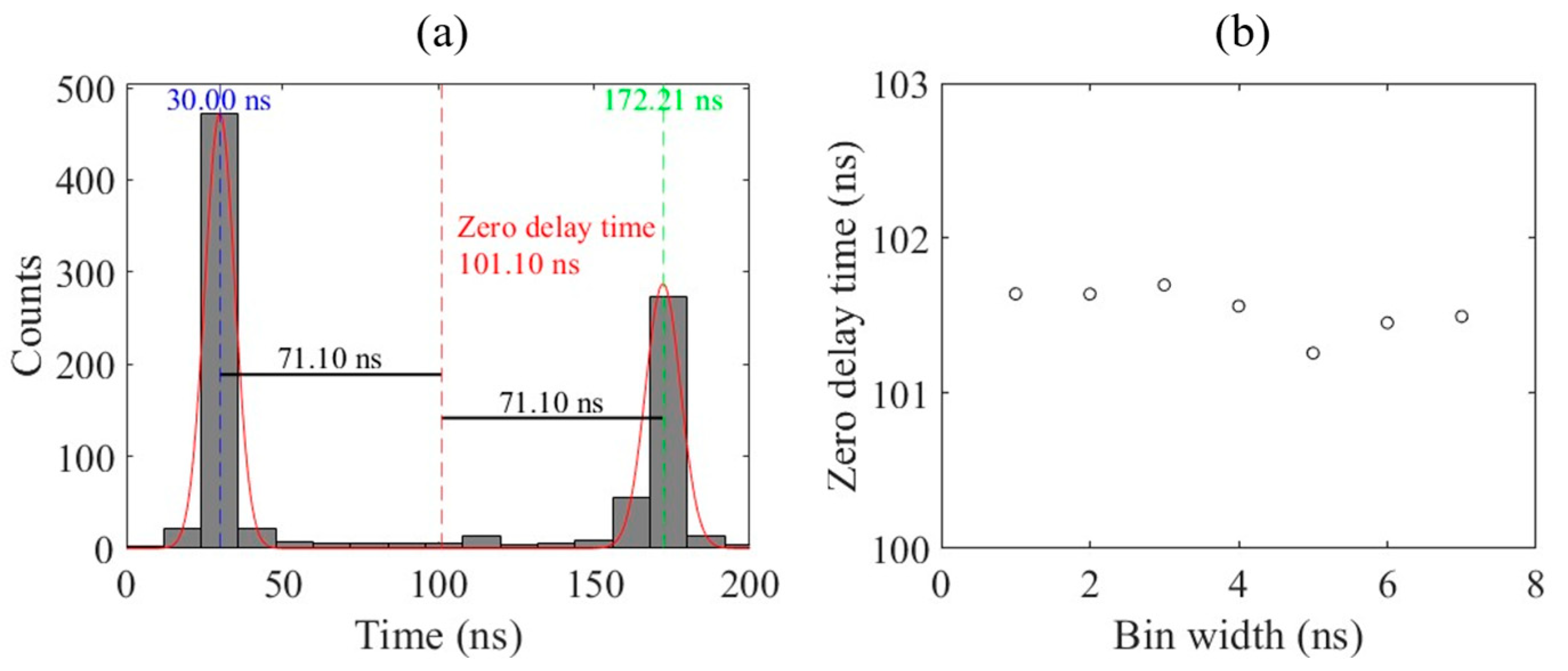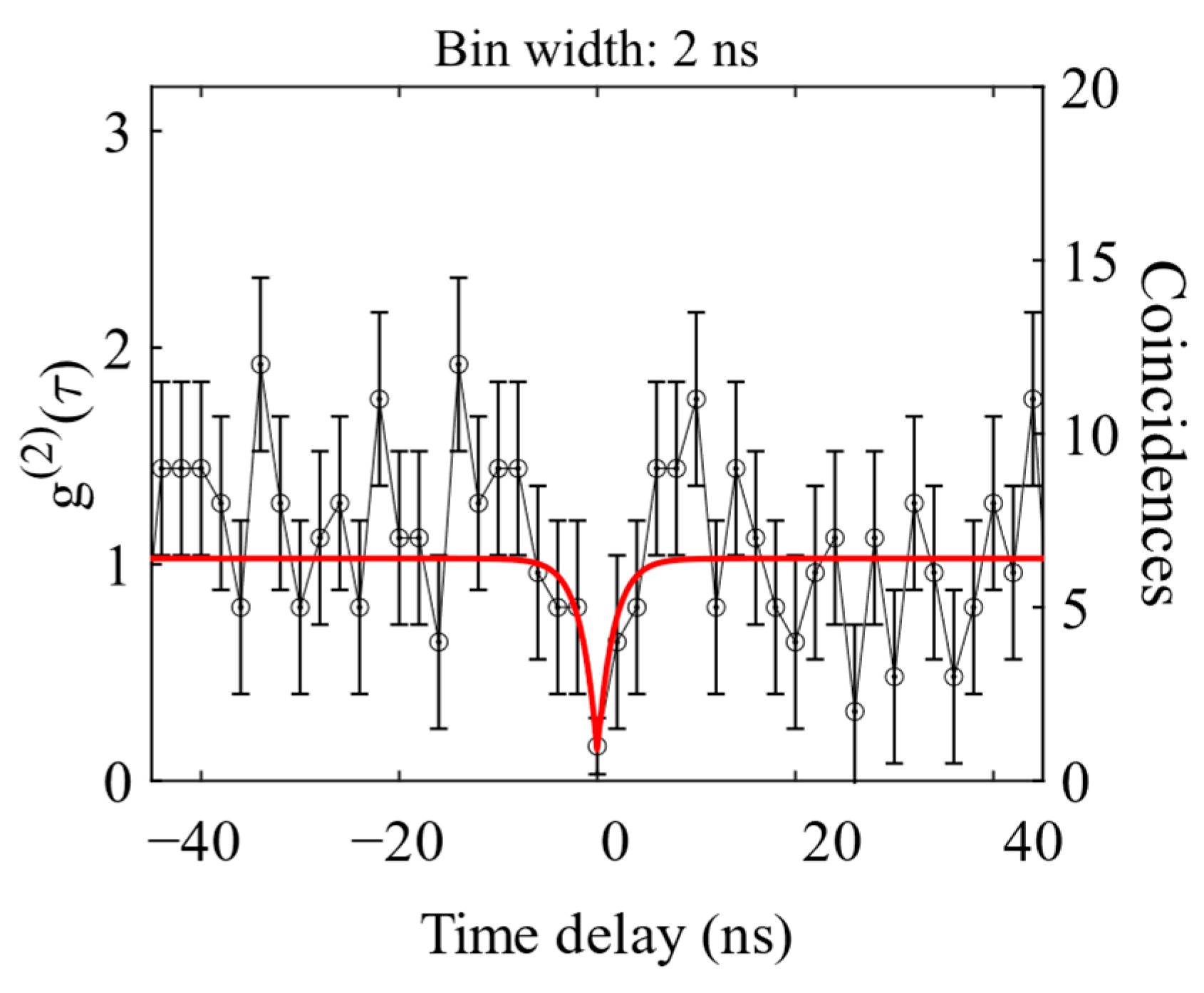Room-Temperature Fiber-Coupled Single-Photon Source from CdTeSeS Core Quantum Dots
Abstract
1. Introduction
2. Materials and Methods
- (1)
- Chemicals
- (2)
- Synthesis of CdSeTeS core quantum dots (cQDs) and quantum dot deposition
- (3)
- Photoluminescence measurement
- (4)
- The second-order correlation function
- (5)
- Zero-time delay (ZTD) analysis of afterpulsing in APDs
- (6)
- Experimental setup for second-order correlation measurements
3. Results
3.1. Photoluminescence Spectra
3.2. Determine the Zero Time Delay
3.3. Second-Order Correlation
4. Discussion
5. Conclusions
Funding
Institutional Review Board Statement
Informed Consent Statement
Data Availability Statement
Conflicts of Interest
References
- Eisaman, M.D.; Fan, J.; Migdall, A.; Polyakov, S.V. Invited Review Article: Single-Photon Sources and Detectors. Rev. Sci. Instrum. 2011, 82, 071101. [Google Scholar] [CrossRef] [PubMed]
- Walmsley, I.A. Quantum Optics: Science and Technology in a New Light. Science 2015, 348, 525–530. [Google Scholar] [CrossRef] [PubMed]
- Khalid, S.; Laussy, F.P. Perfect Single-Photon Sources. Sci. Rep. 2024, 14, 2684. [Google Scholar] [CrossRef]
- Brassard, G.; Lutkenhaus, N.; Mor, T.; Sanders, B.C. Limitations on Practical Quantum Cryptography. Phys. Rev. Lett. 2000, 85, 1330–1333. [Google Scholar] [CrossRef]
- Tillmann, M.; Daki?, B.; Heilmann, R.; Nolte, S.; Szameit, A.; Walther, P. Experimental Boson Sampling. Nat. Photonics 2013, 7, 540–544. [Google Scholar] [CrossRef]
- Chiangga, S.; Zarda, P.; Jennewein, T.; Weinfurter, H. Towards Practical Quantum Cryptography. Appl. Phys. B 1999, 69, 389–393. [Google Scholar] [CrossRef]
- Kwiat, P.G.; Waks, E.; White, A.G.; Appelbaum, I.; Eberhard, P.H. Ultrabright Source of Polarization-Entangled Photons. Phys. Rev. A 1999, 60, R773–R776. [Google Scholar] [CrossRef]
- Nayak, K.P.; Le Kien, F.; Morinaga, M.; Hakuta, K. Antibunching and Bunching of Photons in Resonance Fluorescence from a Few Atoms into Guided Modes of an Optical Nanofiber. Phys. Rev. A 2009, 79, 021801. [Google Scholar] [CrossRef]
- Nothaft, M.; Höhla, S.; Jelezko, F.; Frühauf, N.; Pflaum, J.; Wrachtrup, J. Electrically Driven Photon Antibunching from a Single Molecule at Room Temperature. Nat. Commun. 2012, 3, 628. [Google Scholar] [CrossRef]
- Kurtsiefer, C.; Mayer, S.; Zarda, P.; Weinfurter, H. Stable Solid-State Source of Single Photons. Phys. Rev. Lett. 2000, 85, 290–293. [Google Scholar] [CrossRef]
- Senellart, P.; Solomon, G.; White, A. High-performance semiconductor quantum-dot single-photon sources. Nat. Nanotech 2017, 12, 1026–1039. [Google Scholar] [CrossRef] [PubMed]
- Shan, G.-C.; Yin, Z.-Q.; Shek, C.H.; Huang, W. Single Photon Sources with Single Semiconductor Quantum Dots. Front. Phys. 2014, 9, 170–193. [Google Scholar] [CrossRef]
- García de Arquer, F.P.; Talapin, D.V.; Klimov, V.I.; Arakawa, Y.; Bayer, M.; Sargent, E.H. Semiconductor Quantum Dots: Technological Progress and Future Challenges. Science 2021, 373, eaaz8541. [Google Scholar] [CrossRef] [PubMed]
- Huang, S.; Huang, G. The Utilization of Quantum Dot Labeling as a Burgeoning Technique in the Field of Biological Imaging. RSC Adv. 2024, 14, 20884–20897. [Google Scholar] [CrossRef]
- Liu, S.; Lin, X.; Liu, F.; Lei, H.; Fang, W.; Jin, C. Observation of Photon Antibunching with Only One Standard Single-Photon Detector. Rev. Sci. Instrum. 2021, 92, 013105. [Google Scholar] [CrossRef]
- Hoang, T.B.; Akselrod, G.M.; Mikkelsen, M.H. Ultrafast Room-Temperature Single Photon Emission from Quantum Dots Coupled to Plasmonic Nanocavities. Nano Lett. 2016, 16, 270–275. [Google Scholar] [CrossRef]
- Xu, X.; Toft, I.; Phillips, R.T.; Mar, J.; Hammura, K.; Williams, D.A. “Plug and Play” Single-Photon Sources. Appl. Phys. Lett. 2007, 90, 061103. [Google Scholar] [CrossRef]
- Schweickert, L.; Jöns, K.D.; Zeuner, K.D.; Covre da Silva, S.F.; Huang, H.; Lettner, T.; Reindl, M.; Zichi, J.; Trotta, R.; Rastelli, A.; et al. On-demand generation of background-free single photons from a solid-state source. Appl. Phys. Lett. 2018, 112, 093106. [Google Scholar] [CrossRef]
- Osypiw, A.R.C.; Lee, S.; Jung, S.-M.; Leoni, S.; Smowton, P.M.; Hou, B.; Kim, J.M.; Amaratunga, G.A.J. Solution-Processed Colloidal Quantum Dots for Light Emission. Mater. Adv. 2022, 3, 6773–6790. [Google Scholar] [CrossRef]
- Ngan, K.; Zhan, Y.; Dory, C.; Vučković, J.; Sun, S. Quantum Photonic Circuits Integrated with Color Centers in Designer Nanodiamonds. Nano Lett. 2023, 23, 9360–9366. [Google Scholar] [CrossRef]
- Fedorych, O.; Kruse, C.; Ruban, A.; Hommel, D.; Bacher, G.; Kümmell, T. Room Temperature Single Photon Emission from an Epitaxially Grown Quantum Dot. Appl. Phys. Lett. 2012, 100, 061114. [Google Scholar] [CrossRef]
- Rakhlin, M.; Sorokin, S.; Kazanov, D.; Sedova, I.; Shubina, T.; Ivanov, S.; Mikhailovskii, V.; Toropov, A. Bright Single-Photon Emitters with a CdSe Quantum Dot and Multimode Tapered Nanoantenna for the Visible Spectral Range. Nanomaterials 2021, 11, 916. [Google Scholar] [CrossRef]
- Rozenman, G.G.; Peisakhov, A.; Zadok, N. Dispersion of Organic Exciton Polaritons-a Novel Undergraduate Experiment. Eur. J. Phys. 2022, 43, 035301. [Google Scholar] [CrossRef]
- Buckley, S.; Rivoire, K.; Vučković, J. Engineered Quantum Dot Single-Photon Sources. Rep. Prog. Phys. 2012, 75, 126503. [Google Scholar] [CrossRef]
- Messin, G.; Hermier, J.P.; Giacobino, E.; Desbiolles, P.; Dahan, M. Bunching and Antibunching in the Fluorescence of Semiconductor Nanocrystals. Opt. Lett. 2001, 26, 1891–1893. [Google Scholar] [CrossRef]
- Muñoz-Matutano, G.; Barrera, D.; Fernández-Pousa, C.R.; Chulia-Jordan, R.; Seravalli, L.; Trevisi, G.; Frigeri, P.; Sales, S.; Martínez-Pastor, J. All-Optical Fiber Hanbury Brown &Twiss Interferometer to Study 1300 Nm Single Photon Emission of a Metamorphic InAs Quantum Dot. Sci. Rep. 2016, 6, 27214. [Google Scholar] [CrossRef]
- Vajner, D.A.; Rickert, L.; Gao, T.; Kaymazlar, K.; Heindel, T. Quantum Communication Using Semiconductor Quantum Dots. Adv. Quantum Technol. 2022, 5, 2100116. [Google Scholar] [CrossRef]
- Jeon, W.B.; Moon, J.S.; Kim, K.-Y.; Ko, Y.-H.; Richardson, C.J.K.; Waks, E.; Kim, J.-H. Plug-and-play Single-photon Devices with Efficient Fiber-quantum Dot Interface. Adv. Quantum Technol. 2022, 5, 2200022. [Google Scholar] [CrossRef]
- Adegoke, O.; Nyokong, T.; Forbes, P.B.C. Structural and optical properties of alloyed quaternary CdSeTeS core and CdSeTeS/ZnS core–shell quantum dots. J. Alloys Compd. 2015, 645, 443–449. [Google Scholar] [CrossRef]
- Adegoke, O.; Nyokong, T.; Forbes, P.B.C. Photophysical properties of a series of alloyed and non-alloyed water-soluble l-cysteine-capped core quantum dots. J. Alloys Compd. 2017, 695, 1354–1361. [Google Scholar] [CrossRef]
- Yang, F.; Xu, Z.; Wang, J.; Zan, F.; Dong, C.; Ren, J. Microwave-assisted aqueous synthesis of new quaternary-alloyed CdSeTeS quantum dots; and their bioapplications in targeted imaging of cancer cells: New quaternary-alloyed CdSeTeS quantum dots. Luminescence 2013, 28, 392–400. [Google Scholar] [CrossRef] [PubMed]
- Prabhakaran, P.; Kim, W.J.; Lee, K.-S.; Prasad, P.N. Quantum Dots (QDs) for Photonic Applications. Opt. Mater. Express 2012, 2, 578. [Google Scholar] [CrossRef]
- Kurtsiefer, C.; Zarda, P.; Mayer, S.; Weinfurter, H. The Breakdown Flash of Silicon Avalanche Photodiodes-Back Door for Eavesdropper Attacks? J. Mod. Opt. 2001, 48, 2039–2047. [Google Scholar] [CrossRef]
- Brown, R.H.; Twiss, R.Q. Correlation between Photons in two Coherent Beams of Light. Nature 1956, 177, 27–29. [Google Scholar] [CrossRef]
- Liao, L.; Zhang, H.; Zhong, X. Facile Synthesis of Red-to Near-Infrared-Emitting CdTexSe1-x Alloyed Quantum Dots via a Noninjection One-Pot Route. J. Lumin. 2011, 131, 322–327. [Google Scholar] [CrossRef]
- Gao, F.; Wang, Y.; Liu, J.; Huang, Q.; Hu, Z.; Tang, M.; Liu, H. Optical fiber antenna employing quantum dots as gas molecule receptors. Sens. Actuators B Chem. 2022, 367, 132036. [Google Scholar] [CrossRef]
- Brouri, R.; Beveratos, A.; Poizat, J.P.; Grangier, P. Photon Antibunching in the Fluorescence of Individual Color Centers in Diamond. Opt. Lett. 2000, 25, 1294–1296. [Google Scholar] [CrossRef]
- Michler, P.; Kiraz, A.; Becher, C.; Schoenfeld, W.V.; Petroff, P.M.; Zhang, L.; Hu, E.; Imamoglu, A. A Quantum Dot Sin-gle-Photon Turnstile Device. Science 2000, 290, 2282–2285. [Google Scholar] [CrossRef]
- Michler, P.; Imamoglu, A.; Mason, M.D.; Carson, P.J.; Strouse, G.F.; Buratto, S.K. Quantum Correlation among Photons from a Single Quantum Dot at Room Temperature. Nature 2000, 406, 968–970. [Google Scholar] [CrossRef]
- Lounis, B.; Bechtel, H.A.; Gerion, D.; Alivisatos, P.; Moerner, W.E. Photon Antibunching in Single CdSe/ZnS Quantum Dot Fluorescence. Chem. Phys. Lett. 2000, 329, 399–404. [Google Scholar] [CrossRef]
- Koehler-Sidki, A.; Dynes, J.F.; Paraïso, T.K.; Lucamarini, M.; Sharpe, A.W.; Yuan, Z.L.; Shields, A.J. Backflashes from Fast-Gated Avalanche Photodiodes in Quantum Key Distribution. Appl. Phys. Lett. 2020, 116, 154001. [Google Scholar] [CrossRef]
- Marini, L.; Camphausen, R.; Eggleton, B.J.; Palomba, S. Deterministic Filtering of Breakdown Flashing at Telecom Wavelengths. Appl. Phys. Lett. 2017, 111, 213501. [Google Scholar] [CrossRef]
- Texas Instruments. “User’s Guide, TDC7201-ZAXEVM” SNAU198A, May 2016. Available online: https://www.ti.com/lit/ug/snau198a/snau198a.pdf (accessed on 4 January 2025).
- Huang, C.-H.; Wen, Y.-H.; Liu, Y.-W. Measuring the Second Order Correlation Function and the Coherence Time Using Random Phase Modulation. Opt. Express 2016, 24, 4278–4288. [Google Scholar] [CrossRef] [PubMed]
- Lukishova, S.G.; Schmid, A.W.; McNamara, A.J.; Boyd, R.W.; Stroud, C.R. Room Temperature Single-Photon Source: Single-Dye Molecule Fluorescence in Liquid Crystal Host. IEEE J. Sel. Top. Quantum Electron. 2003, 9, 1512–1518. [Google Scholar] [CrossRef]
- Fishman, R.E.K.; Patel, R.N.; Hopper, D.A.; Huang, T.-Y.; Bassett, L.C. Photon-Emission-Correlation Spectroscopy as an Analytical Tool for Solid-State Quantum Defects. PRX Quantum 2023, 4, 010202. [Google Scholar] [CrossRef]
- PerkinElmer SPCM-AQ4C Single Photon Counting Module Array, Data Sheet, PerkinElmer. 2005. Available online: https://www.excelitas.com/product/spcm-aq4c (accessed on 4 January 2025).
- Pan, Z.; Zhao, K.; Wang, J.; Zhang, H.; Feng, Y.; Zhong, X. Near infrared absorption of CdSe(x)Te(1-x) alloyed quantum dot sensitized solar cells with more than 6% efficiency and high stability. ACS Nano 2013, 7, 5215–5222. [Google Scholar] [CrossRef]
- Bennett, C.H.; Brassard, G. Quantum cryptography: Public-key distribution and coin tossing. In Proceedings of the IEEE International Conference on Computers, Systems, and Signal Processing, Bangalore, India, 9–12 December 1984; IEEE: New York, NY, USA, 1984; pp. 175–179. [Google Scholar]
- O’Brien, J.L.; Furusawa, A.; Vučković, J. Photonic Quantum Technologies. Nat. Photonics 2009, 3, 687–695. [Google Scholar] [CrossRef]






Disclaimer/Publisher’s Note: The statements, opinions and data contained in all publications are solely those of the individual author(s) and contributor(s) and not of MDPI and/or the editor(s). MDPI and/or the editor(s) disclaim responsibility for any injury to people or property resulting from any ideas, methods, instructions or products referred to in the content. |
© 2025 by the author. Licensee MDPI, Basel, Switzerland. This article is an open access article distributed under the terms and conditions of the Creative Commons Attribution (CC BY) license (https://creativecommons.org/licenses/by/4.0/).
Share and Cite
Chiangga, S. Room-Temperature Fiber-Coupled Single-Photon Source from CdTeSeS Core Quantum Dots. Photonics 2025, 12, 52. https://doi.org/10.3390/photonics12010052
Chiangga S. Room-Temperature Fiber-Coupled Single-Photon Source from CdTeSeS Core Quantum Dots. Photonics. 2025; 12(1):52. https://doi.org/10.3390/photonics12010052
Chicago/Turabian StyleChiangga, Surasak. 2025. "Room-Temperature Fiber-Coupled Single-Photon Source from CdTeSeS Core Quantum Dots" Photonics 12, no. 1: 52. https://doi.org/10.3390/photonics12010052
APA StyleChiangga, S. (2025). Room-Temperature Fiber-Coupled Single-Photon Source from CdTeSeS Core Quantum Dots. Photonics, 12(1), 52. https://doi.org/10.3390/photonics12010052




